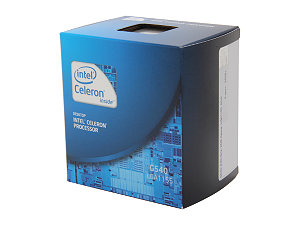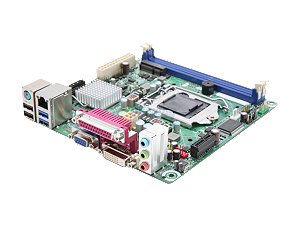Holiday 2012 Small Form Factor Buyer's Guide
by Zach Throckmorton on December 5, 2012 1:55 AM ESTSmall Size, Small Price Tag
While Intel has yet to release Ivy Bridge-based Celeron-class (i.e. cheap) CPUs, I briefly reviewed the Celeron G530's performance in a previous budget buyer's guide. Intel has, however, given its entry-level chips a modest speed bump in that the Celeron G540 and G550 models are often available for a dollar or two more than the G530. Because they are adequate for day-to-day tasks and are priced so low, they remain the kings of the budget CPUs.
 We've paired the Celeron G540 with one of the least expensive ITX Socket 1155 motherboards, Intel's BOXDH61DLB3. While there are less expensive boards, reliability issues prevent us from giving them the nod in this buyer's guide. Intel's entry-level ITX model offers basic features as well as USB 3.0 ports. Note that it does not have a PCIe x16 lane, instead offering a single PCIe x1 lane. This is likely not a concern for a budget, general office productivity box that will likely never need a video card installed but might need a wireless adapter card. Furthermore, its SATA ports are limited to SATA II speeds, so the newest SSDs that use SATA III will be crippled. Again, though, this is a budget system and something has to give. If you need a PCIe x16 lane and SATA III ports, you'll need to step up to a board like ASRock's B75M-ITX or ASUS' P8H77-I.
We've paired the Celeron G540 with one of the least expensive ITX Socket 1155 motherboards, Intel's BOXDH61DLB3. While there are less expensive boards, reliability issues prevent us from giving them the nod in this buyer's guide. Intel's entry-level ITX model offers basic features as well as USB 3.0 ports. Note that it does not have a PCIe x16 lane, instead offering a single PCIe x1 lane. This is likely not a concern for a budget, general office productivity box that will likely never need a video card installed but might need a wireless adapter card. Furthermore, its SATA ports are limited to SATA II speeds, so the newest SSDs that use SATA III will be crippled. Again, though, this is a budget system and something has to give. If you need a PCIe x16 lane and SATA III ports, you'll need to step up to a board like ASRock's B75M-ITX or ASUS' P8H77-I.
Housing the budget build is Apex's MI-008, a longtime favorite of mine for cheap ITX systems. It's reasonably well-constructed, and comes with a serviceable 250W power supply. Its thermals aren't particularly impressive, but for a system lacking a discrete graphics card and running a Sandy Bridge Celeron, it doesn't need to have the best airflow. The MI-008 can accommodate full size hard and optical drives, which helps keep costs down.
 As for the memory, a single 4GB stick of budget DDR3-1333MHz is sufficient for basic computing in Windows 7 64-bit (or Windows 8 if you want to go that route), and leaves an open slot so upgrading to 4GB in the future will be cheap and easy. Hard drive and solid state drive prices are especially dynamic this time of year, making recommendations difficult. While day to day hard drive prices remain elevated in the wake of the notorious Thailand floods, sale prices are beginning to get back to where they were before hard drive supplies were disrupted late last year. If you're patient and pay attention to prices, you will likely be able to snag a mainstream 7200RPM 1TB hard drive for $60 or less. If you don't need much local storage, a 64GB SSD will give you an enormous performance boost for about the same price.
As for the memory, a single 4GB stick of budget DDR3-1333MHz is sufficient for basic computing in Windows 7 64-bit (or Windows 8 if you want to go that route), and leaves an open slot so upgrading to 4GB in the future will be cheap and easy. Hard drive and solid state drive prices are especially dynamic this time of year, making recommendations difficult. While day to day hard drive prices remain elevated in the wake of the notorious Thailand floods, sale prices are beginning to get back to where they were before hard drive supplies were disrupted late last year. If you're patient and pay attention to prices, you will likely be able to snag a mainstream 7200RPM 1TB hard drive for $60 or less. If you don't need much local storage, a 64GB SSD will give you an enormous performance boost for about the same price.
While Windows 7 64-bit remains the de facto standard operating system for PCs, note that Windows 8 64-bit is now also available. Note that for this budget build, the $92 Windows license accounts for about 25% of the total cost. If you're on an extremely tight budget, or simply want to explore other operating systems, be sure to check out a free OS like Ubuntu.
| Component | Product | Price |
| Case | Apex MI-008 | $48 |
| Power supply | (included with case) | |
| CPU | Intel Celeron G540 2.5GHz dual-core | $45 |
| Motherboard | Intel BOXDH61DLB3 mITX | $72 |
| RAM | G.Skill Value 4GB DDR3-1333MHz | $18 |
| Hard drive | Seagate Barracuda 1TB ST1000DM003 | $70 |
| SSD alternate | Intel 330 Series 60GB | $70 |
| Optical drive | Samsung SH-224BB DVD burner | $16 |
| Operating system | Windows 7 64-bit Home Premium OEM | $92 |
| Total: | $361 |
Check the next page for our small form factor file server build.










74 Comments
View All Comments
jackstar7 - Wednesday, December 5, 2012 - link
I still build the occasional Shuttle and going Open Box from Newegg makes them often an excellent deal. Given that power needs have dropped significantly over the years, a Shuttle can stay cool and quiet these days and deliver a very solid experience.While folks might want to have their hands in all of the parts of a build, there's still value in what Shuttle brings to the desk. My most recent build included a 3770S and serves its owner very well so far. I also have a very minimalist Shuttle running with a 2400S for my HTPC and it runs more quietly than my PS3.
marvdmartian - Wednesday, December 5, 2012 - link
Hopefully their power supply problems have been solved by now? Last time I bought a Shuttle SFF system (~5 years ago), it ran fine for the first 2 years, then fried a power supply, which eventually led to a fried motherboard (lasted ~2 weeks, then died). Being a micro-BTX system, it was easier (and cheaper) to simply replace it with a standard micro-ATX case & motherboard.jackstar7 - Wednesday, December 5, 2012 - link
They started using rated 80+ PSUs that have shown me no trouble at all. Even the ones from a few years back rarely gave me any trouble at all and I was packing the things with high-power GPUs and OC-ing my CPU.I use a full tower for myself these days, but I still keep an eye on Shuttle because there are times when it's just a plain good deal.
roland12321 - Thursday, December 6, 2012 - link
I can't believe he's hammering at Shuttle there... I bought a Shuttle back in 2004 and only stopped working last year, because I accidentally damaged the motherboard because I had to replace its bios battery. Even that system was an AMD (single core, though), also using an 80mm fan and it worked fine. The only things I replaced over the years was a hard disk and a video card. Mind you, the power supply of the old Shuttle was only 250W. Maybe people were overloading their power supply without realising it, causing it to pop.As a matter of fact, because it ran so well, earlier this year I bought a new Shuttle SH67H3 and it still runs like a dream! I can't overclock my CPU (which is logical) but I have zero complaints. My next PC will also definitely be a Shuttle! It's powering the i5-2500 with a HD 7850 without any issues at all.
Also, Shuttle make their own motherboards, and are WAAYYYY ahead of any other competitor on the small form factor field. Have a look at their website, all their products are quite impressive. And I agree with jackstar7, Shuttle PCs don't make any noise. I accidentally turned it off once because I didn't hear it being on. Maybe the reviewer was running his fans at 100%?
Imo Shuttle deserves more respect...
max347 - Wednesday, December 5, 2012 - link
I think page 2 should read 4TB instead of 4GB (last paragraph)sligett - Wednesday, December 5, 2012 - link
"the plural of anecdote is not data."Well said.
Mumrik - Wednesday, December 5, 2012 - link
Best sentence in the entire article.tjcinnamon - Wednesday, December 5, 2012 - link
I have a Synology NAS and one thing I like is that it sleeps until it's hit with a request for data. Can a fileserver be set to sleep after a set amount of activity but then awake on data request (not WOL because it's a data request).Thanks,
JOe K.
bobbozzo - Friday, December 7, 2012 - link
Probably not, but you can tell the OS to put the disks to sleep after a inactivity timeout.Guspaz - Wednesday, December 5, 2012 - link
In my Shuttle SZ77R5, I've got an i7-3770k, a GeForce GTX 670, 16GB of RAM, two SSDs (with room for a third in mSATA format), and a BluRay burner. There is also room for an mPCIe wifi adapter if I should feel so inclined. Alternatively, I could have gone with one mSATA SSD and two 3.5" HDDs for bulk storage, but I have a big file server and so don't need bulk storage in my desktop.It's hard to imagine what else you might need in a typical gaming PC. I guess there could be people who have need of more than one optical drive, or more than three hard disks, or some monster dual GPU graphics card, but those people would be few and far between.
There is one critical flaw in the system, though. The BIOS (even the latest update claiming to fix the problem) can't read the temperature properly from IvyBridge CPUs, and as such, will let the thing fry before spinning up the CPU fan. Your options are either to permanently run it on jet-engine-loud mode, or to do what I did and use something like SpeedFan to do a custom fan profile.
Having to use SpeedFan isn't a problem for me, but someone less technically inclined may not be able to solve the problem like this, and would consider it a fatal flaw.